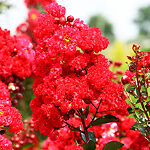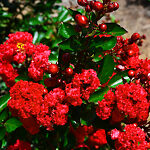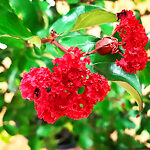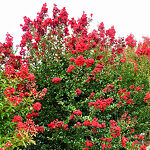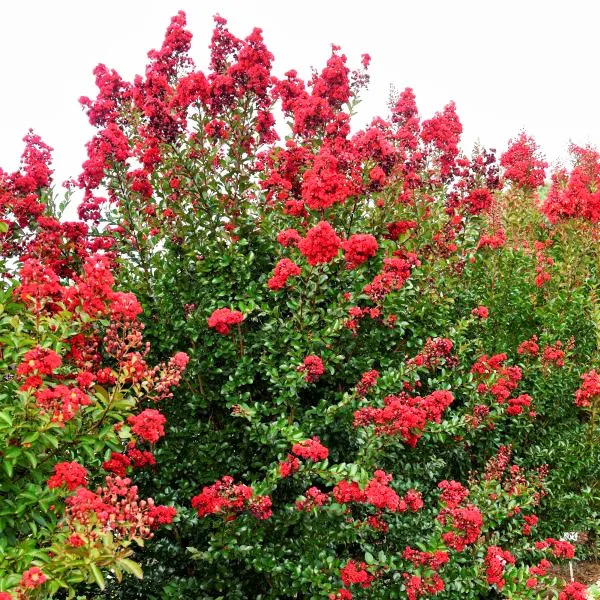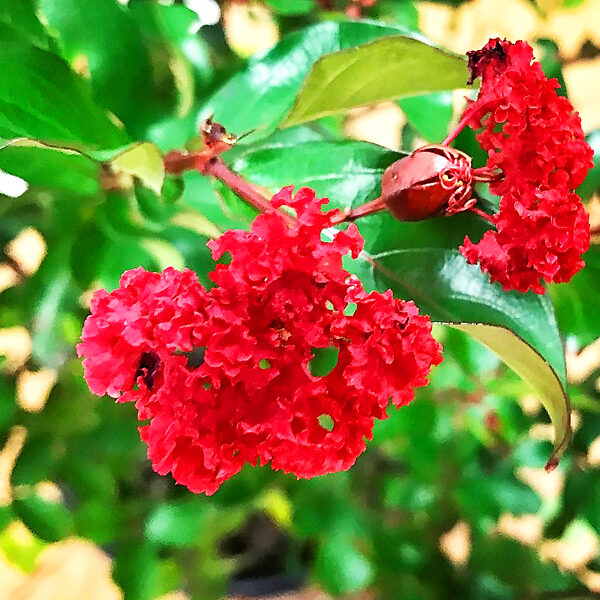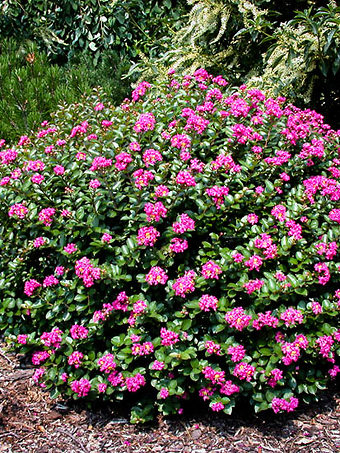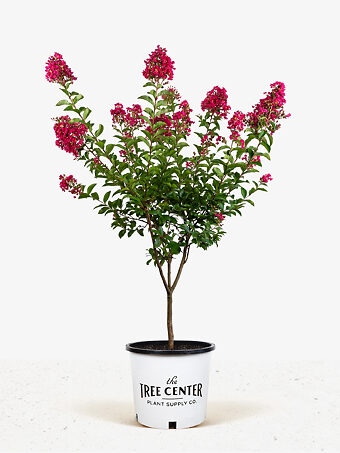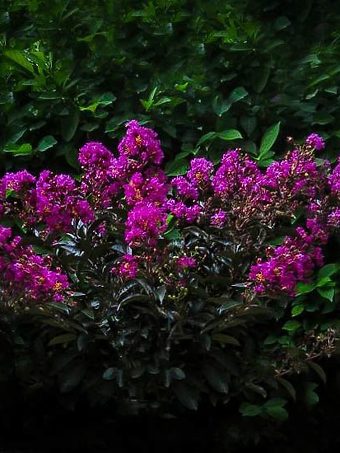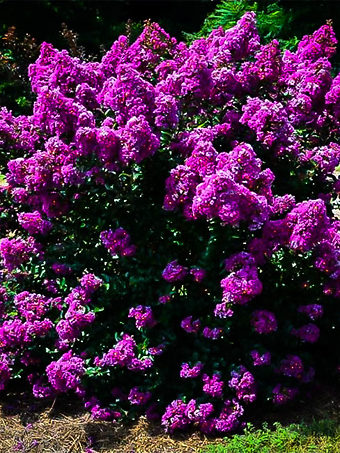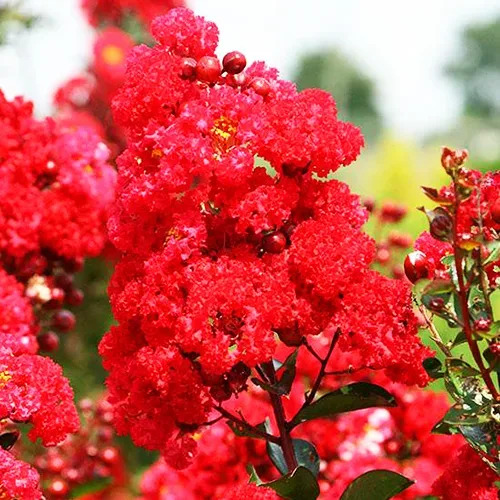
Red Magic Crape Myrtle
Lagerstroemia hybrid 'PIILAG-VI' (PP#26,183)View more from Crape Myrtle Trees
Red Magic Crape Myrtle
Lagerstroemia hybrid 'PIILAG-VI' (PP#26,183)
30 day - ARRIVE AND THRIVE™ guaranteeLearn more


Special Features

Botanical Name
Lagerstroemia hybrid 'PIILAG-VI' (PP#26,183)
Outdoor Growing zone
6-9
Mature Height
6-10
Mature Width
6-10
Sun needs
Full Sun
DOES NOT SHIP TO
AK, CA, HI, PR
The Red Magic™ Crape Myrtle is a rounded shrub growing between 6 and 10 feet tall and wide. It has dense branching and attractive foliage that is red in spring, green in summer and red again in fall. Because this bush is disease resistant, those leaves stay fresh and green all season. The brilliant red flowers are the main feature, with blooming from June to September. For a big splash of color, plant at the back of your shrub beds, or around the house. Grow it on a lawn as a specimen, or in a row for screening and as a boundary.
- Bold red flowers all summer and into fall
- Red new leaves and stems
- Full, rounded form for screening and filling beds
- Fully resistant to leaf diseases
- Reliable in hot and dry areas
Grow the Red Magic™ Crape Myrtle in full sun to enjoy the most blooms. Plant it in any well-drained soil, including poor and dry soils, where it will thrive once established. It is drought resistant, immune to diseases, largely pest free and untouched by deer. A simple spring pruning, either lightly or more intensely, is all the care needed, plus removing the spent flowers after the first blooming, to encourage lots of new flower stems.
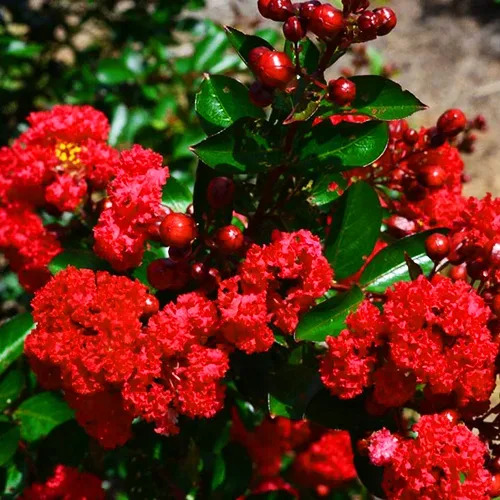
Robust, rounded shrubs are great for background and as space fillers, because their broad form means you need fewer of them for a given area, and their form is a great screen or background. Many crape myrtles are tree-like, or upright, but the Red Magic™ Crape Myrtle has a rounded form as wide as it is tall. It’s unbeatable for a dense screen, or for filling corners around your home or out in the yard. It is smothered in vibrant rich red blooms all through summer, and unbeatable for hot and dry areas in any garden. Reaching well over 6 feet tall and wide, and up to 10 feet after a few more years, it is perfect in tubs too, where it will be smaller, but just as full and dense.
Growing the Red Magic™ Crape Myrtle
Size and Appearance
The Red Magic Crape Myrtle is a rounded deciduous shrub, growing between 6 and 10 feet tall, with the same width. It forms a ball-shaped plant, with many branches from the ground, and a dense, leafy structure. The stems have flaking bark when they are older, in shades of gray and brown. This looks attractive in winter, when the leaves are gone. The leaves are a little larger than in many crape myrtles, increasing the density of the plant. They are about 2 inches long and 1 inch wide, with a lustrous, smooth surface, an oval shape, and smooth edges. When they are newly emerged, in spring or through summer, the leaves and young stems are a bold orange-red color. As the leaves mature, they turn a dark, rich green, and in fall they turn orange and deep red.
The first flowers open in early June, and flowering can continue right into September, with a big blooming in summer and then another one in early fall, with an interval of a month or so between them. The flowers are in clusters of 30 to 50 blooms, and these fat clusters, 4 inches tall, are carried at the end of every new branch. They bloom profusely over a two-week period, keeping those blossoms coming and coming. The flowers are crinkly, like crepe paper, and they are a brilliant red, the richest and deepest red-pink you have ever seen. Bright yellow stamens fill the center of each flower. The petals fall cleanly leaving a cluster of developing seed pods.
Using the Red Magic™ Crape Myrtle in Your Garden
This is a plant for the background of larger beds, or as a specimen on a large lawn. Bright and colorful all summer, it will give your garden a real lift. Plant it on the sunny side of your home, facing south or west, where it will brighten up your foundation planting and introduce summer color among your evergreens. It can also be grown in a large tub or planter, where it will probably grow no more than 5 feet tall – perfect for the corner of a patio or terrace. Use a row, spaced 4 or 5 feet apart, to hide an old fence or create a boundary.
Hardiness
Grow the Red Magic Crape Myrtle in zones 7 to 9. It will also grow in zone 6, but there the branches will often die back to the ground. It will re-sprout from the roots, and still bloom profusely, making a shrub for the middle or front of beds, reaching about 3 feet in a season.
Sun Exposure and Soil Conditions
Always plant in full sun for maximum blooming and compact growth. Even a little shade will reduce blooming significantly. It thrives in all well-drained soils, including poor soils, and in dry places, once established.
Maintenance and Pruning
Older varieties of crape myrtle often turn dusty gray in summer, or develop leaf spots and falling leaves, leaving plants looking thin and bare. Not the Red Magic Crape Myrtle, which is highly resistant to both powdery mildew and Cercospora leaf spot. Pests normally cause no problems, deer normally leave it alone, and this tough plant is very easy to grow. Water regularly during the first season, but after that, once it is established, it has very good drought resistance, and thrives in hot, dry places.
We recommend removing the seed pods right after the first flowering, to encourage the development of more blooms. Flowers in fall can be allowed to produce pods, as these are an interesting winter feature. Spring is the best time to trim your bush, if you wish to. Do it when the branches are still bare and leafless. Trim lightly for neatness by removing the top 12 inches of each branch and remove any weak or broken branches at the base. For a smaller bush, remove more of the stems, but always leave a few inches of the previous years’ growth, to allow for rapid new growth and plenty of blooms. Don’t trim during summer, as this will reduce flowering.
History and Origin of the Red Magic™ Crape Myrtle
Crape Myrtle, Lagerstroemia indica, has a long history in the south, and it has been a big hit in gardens ever since it was brought to Charleston in 1786, by the French explorer and botanist André Michaux. He had found it in England, where it rarely blooms because of the cold and wet weather, but it had originally arrived there from China, with early traders, by 1759.
Those original plants have today been replaced by improved forms, resistant to disease and much more prolific with their blooming. Michael Dirr and Joshua Kardos, prominent American plant breeders, set up their company Plant Introductions, Inc. in Watkinsville, Georgia, to create new lines of valuable garden plants. Their Magic series of crape myrtles are all outstanding, and in 2008 they took seeds from plants of an earlier one, the Red Rooster Magic crape myrtle (‘Piilag-III’) and grew many seedlings. Among them they found an outstanding bushy plant, with brilliant red flowers, and they patented it in 2015 with the name ‘PIILAG-VI’. It became the Red Magic™ Crape Myrtle, and it has been released by Bailey Nurseries, as part of their First Editions® new garden plants.
Buying the Red Magic™ Crape Myrtle at The Tree Center
Bushy, compact crape myrtles have become the ‘new normal’ for these plants, very different from the older tree-like forms. Combining color and dense structure, the Red Magic Crape Myrtle is an assured favorite, and for disease resistance and easy growth it can’t be beaten. Order your plants now, relax and enjoy easy garden color for months and months. Act quickly, though, because our limited supply will soon run out.
